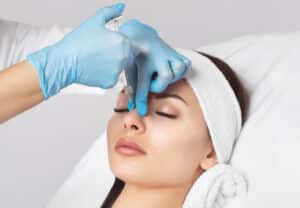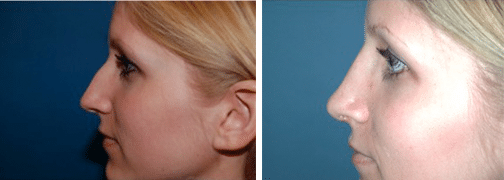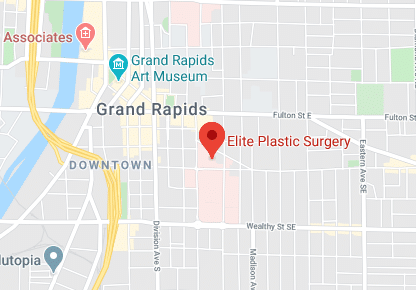
What is Rhinoplasty?
Rhinoplasty, or nose surgery, is one of the most popular plastic surgery procedures. This well-known and effective surgery is designed to not only change the appearance of the nose but to create facial symmetry that can improve the appearance of the entire face. Rhinoplasty can also be used strictly to correct a deviated septum, a structural problem that interferes with breathing.
Benefits of Nose Surgery
There are several benefits of nose surgery; they include facilitating breathing as well as improving appearance. During rhinoplasty, the surgeon may attempt to do one or more of the following:
- Balance the nose size in relation to face
- Reduce the nose width at the bridge
- Improve the profile by removing nose bumps or depressions
- Reduce nostril size and position
- Reduce nasal tip malformation that can cause the nose to appear bulbous, drooped, upturned or hooked
Correcting the physiological problem of a deviated septum can be achieved by adjusting the nasal structure to improve alignment. A deviated septum is one of the most common natural causes of difficult breathing.
Rhinoplasty Candidates
To ensure the best outcomes, rhinoplasty candidates should be healthy and realistic about possible results. They should be at least 16-20 years of age. This is to ensure that their facial growth is complete. With this surgery, it’s particularly important that patients don’t smoke.
Rhinoplasty Procedure
Your doctor will recommend either intravenous sedation or general anesthesia, depending on your procedure.
- Closed Incision Procedure: Incisions are inside the nose (within nostrils).
- Open Incision Procedure: Incision is across the narrow strip of tissue that separates the nostrils.
The skin that covers the nasal bones and cartilages is raised, allowing access to reshape the nose structure. The surgery varies depending on the alternations being made, for example:
- A large nose: Often reduced by removing bone or cartilage, and may require cartilage grafts.
- A deviated septum: Straightened and any projections inside the nose reduced to improve breathing.
Once the underlying structure of the nose is the desired shape, the surgeon will re-drape nasal skin and tissue and then close incisions.
How Long Does a Rhinoplasty Procedure Take?
Depending on the extent of revisions, nose surgery takes about two hours.
Does Rhinoplasty Require Anesthesia?
Nose Surgery will require either local or general anesthesia.
Nose Surgery Recovery
During initial healing, your surgeon will place a splint and/or packing inside the nose and a splint or bandages on the outside. Initial swelling should subside within a few weeks, but may be worse in the morning during the first year following your surgery. It can take up to a year for the nose to fully refine. During this time, gradual improvement should be noticeable. Your experience will be unique to you, and your surgeon can answer specific questions about what to expect during the recovery period.
You will have specific instructions for:
- Incision care
- Any bandage removal or changing
- Necessary medications, topical and oral
- Activities, food and medications to avoid
- Problems to watch for
- Resumption of normal activities/exercise
- Follow up appointments
Rhinoplasty Results
Rhinoplasty surgery adjusts a delicate part of the face, in which soft tissue, bone, and cartilage may all be involved. The results of rhinoplasty are intended to be permanent and natural-looking. Understandably, patients want to know what to expect both in terms of the timing of their results and the final outcome.
The final results of rhinoplasty are impossible to predict. It is crucial that you and your surgeon engage in thoughtful discussion about what you want to achieve, what you expect, and what is and is not possible with rhinoplasty. No rhinoplasty leads to an absolutely perfect nose. Every nose has nuances in shape and size. The intent with rhinoplasty is to refine these nuances to create the best possible symmetry across the entire face.
The timing of rhinoplasty results is also an important aspect of this journey. Patients can expect for their results to take 1 to 2 years to fully settle in. Initially, uneven swelling in the nose and the cheek area can make the nose appear less symmetrical and out of shape. By four weeks post-op, a significant amount of improvement is typically seen. By this time, most patients feel quite happy about their results. However, tissue remodeling continues for another several months. From six months to two years post-op, patients continue to see the tip of their nose become increasingly more refined.
Nose Surgery Before & After
*Individual results may vary
View more before and after photos
Rhinoplasty Patient Testimonial
*Thank you so much for everything. I am very pleased with my surgery and also with the kindness and caring of you and your staff….Read More
Can a Rhinoplasty Be Combined with Other Procedures?
Because nose shape and size relate to other facial features, especially the chin, rhinoplasty may be combined with other procedures. According to the Golden Ratio of beauty, the tip of the nose and the tip of the chin should reach near-equal projection. Chin augmentation with rhinoplasty can balance these two features. Additionally, some patients combine facial procedures such as brow lift or eyelid surgery with their rhinoplasty.
What Is a Revision Rhinoplasty?
The majority of rhinoplasty surgeries achieve lasting, beautiful results. However, statistics indicate that approximately 15 percent of patients seek revision rhinoplasty. This procedure is corrective in nature and is performed to address problems that have resulted from a primary rhinoplasty, such as nasal blockage or a poor aesthetic outcome.
Will I Have a Scar After Nose Surgery?
Scarring is a natural byproduct of surgery and is an expected side effect of rhinoplasty, regardless of an open or closed technique. Closed rhinoplasty procedures involve incisions only within the nose, where resulting scars should be completely hidden. An open rhinoplasty requires one incision on the outside of the nose. This triangular incision is made on the underside of the columella between the nostrils. This positioning makes the tiny scar difficult to see.
Are There Any Non-Surgical Alternatives to Rhinoplasty Surgery?
Dermal Fillers

What are the Disadvantages of Using Dermal Fillers as an Alternative to Rhinoplasty?
As convenient as nonsurgical rhinoplasty is, there are important points that patients need to understand. One is that injections cannot solve all complaints. For instance, a very large bump may not be fully hidden with fillers. A very wide nose cannot be narrowed using fillers. Another consideration that needs to be made is longevity and cost-effectiveness. Because injections must be repeated every few years to sustain results, this approach is ultimately more costly. Finally, non-surgical rhinoplasty is not without risk and should only be obtained by a provider who has years of experience using this technique.
Is Nose Surgery Covered by Insurance?
Insurance coverage may be available in certain circumstances of rhinoplasty. Typically, for an insurance company to extend benefits for rhinoplasty, one needs to prove medical necessity, such as a structural deformity that is affecting breathing. Rhinoplasty to repair a traumatic injury such as from an auto accident may also be covered under insurance. However, cosmetic rhinoplasty is not.
Schedule a Consultation
If you’re considering nose surgery, call (616) 459-1907 to schedule a consultation at Elite Plastic Surgery.Our practice serves Grand Rapids and surrounding areas in Michigan.
Schedule a Consultation Today


